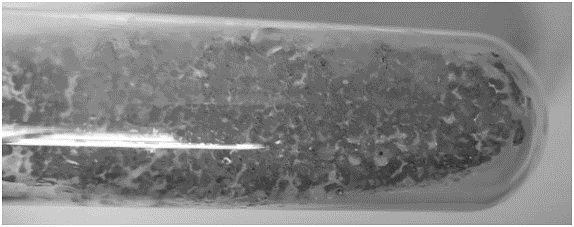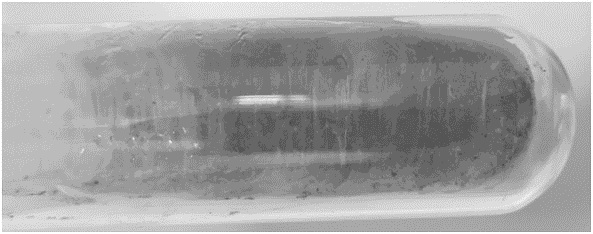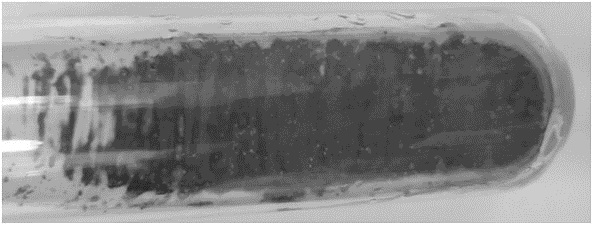Method for screening strain with high yield of Zhongshengmycin
A technology for high-yielding strains and biotins, applied in microorganism-based methods, biochemical equipment and methods, botanical equipment and methods, etc., can solve problems such as low content of biotins, achieve rational and rapid screening, and wide sources. , the effect of low cost
- Summary
- Abstract
- Description
- Claims
- Application Information
AI Technical Summary
Problems solved by technology
Method used
Image
Examples
Embodiment 1
[0035] Embodiment 1: preparation of original bacterial strain bacterial suspension
[0036] Step 1: Streptomyces lilacinus varietus Hainan var. Streptomyces lavendulae var. hainanensis new var. ) slope (such as figure 1 ) spores were inoculated into the shake flask activation medium at a constant temperature of 30°C and 250rpm for 3 hours to form a germinated bacterial suspension (such as Figure 4 ). Among them, shake flask activation medium ingredients: soluble starch (AR) 1.0%, MgSO 4 ·7H 2 O(AR)0.05%, KH 2 PO 4 (AR) 0.1%, KCl (AR) 0.05%, NaNO 3 (AR) 0.2%, FeSO 4 ·7H 2 O(AR) 0.001%, prepared with distilled water, the pH before disinfection is 6.8-7.2, and the pH after disinfection is controlled at 6.8-7.0.
Embodiment 2
[0037] Embodiment 2: Mutagenesis of Zhongshengmycin Starting Strain
[0038] Step 2 Take 800 μL of the germinated bacterial suspension cultured in Example 1, add 200 μL of 20% glycerol, shake and disperse to prepare the bacterial suspension to be mutated.
[0039] Step 3 Take 15 μL of the bacterial suspension to be mutated and drop it on the slide of the ARTP mutagenesis breeding instrument, spread it evenly, and use the ARTP mutagenesis breeding instrument to undergo ARTP mutagenesis (irradiation power 120W, 25°C, helium flow rate 8-12SLM, irradiation for 70 seconds) to obtain a mutagenic solution.
[0040] Step 4 Wash the mutagenesis solution with sterile saline.
[0041] Step 5 Under red light, dilute the mutagenesis solution with normal saline gradient to 10 -4 、10 -5 、10 -6 , smeared on a plate containing LiCl medium and cultured at a constant temperature of 30°C for 12 days.
[0042] The medium composition of LiCl medium plate: soluble starch (AR) 2.0%, beef extract...
Embodiment 3
[0050] Embodiment 3: Inclined-plane bacterial lawn comparison
[0051] The starting strain 1# and the high-yielding strain 46# were inoculated on the slant medium respectively, and cultured at a constant temperature of 30°C. It was found that the lawn of 46# changed faster than the starting strain 1#. After 12 days of cultivation, 1# bacterial lawn (such as figure 1 ) is thinner, uniform lavender gray overall, while 46# bacterial lawn (such as image 3 ) is thicker than 1#, uniform overall, and the color is darker lavender gray than 1#. Compared with 1#, after two generations of passage, the slant bacterial lawn (such as figure 2 ) becomes thinner and even translucent, uniform and fine, pale pink. After counting the spores on the inclined plane, the number of spores in the test tubes of 1# and 46# were 3.9╳10 9 CFU and 7.9╳10 9 CFU, and the number of spores in the test tube after 1# passage for two generations has dropped to 6.8╳10 8 CFU.
PUM
 Login to View More
Login to View More Abstract
Description
Claims
Application Information
 Login to View More
Login to View More - R&D
- Intellectual Property
- Life Sciences
- Materials
- Tech Scout
- Unparalleled Data Quality
- Higher Quality Content
- 60% Fewer Hallucinations
Browse by: Latest US Patents, China's latest patents, Technical Efficacy Thesaurus, Application Domain, Technology Topic, Popular Technical Reports.
© 2025 PatSnap. All rights reserved.Legal|Privacy policy|Modern Slavery Act Transparency Statement|Sitemap|About US| Contact US: help@patsnap.com



